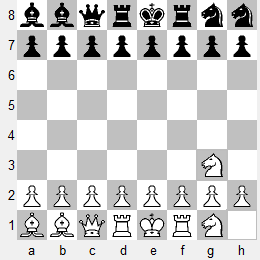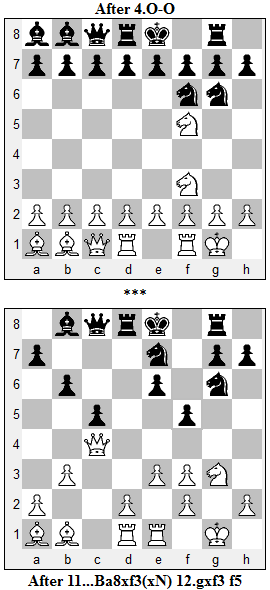
The first trial with this position is recorded on HarryO's Chess960 Jungle blog in Non-Random Chess960 Trial Game 9: SP864. I had White, HarryO Black. He defended the mate threat in the most direct way -- giving up the castles O-O option. After the initial moves, 1.Ng3 Nf6 2.Nf5 Rg8 3.Nf3 Ng6 4.O-O, we reached the position shown in the top diagram below. Harry played his next move, 4...b6, and commented,
Preparing to attack the g2 square and hopefully open access to the h3 square as well. Black is reluctant to play anything other than rock solid moves that try not to induce a second weakness into Black's army.
The next sequence in the game was 4...b6 5.c4 d5 6.cxd5 Bxd5 7.b4 c5 8.bxc5 Nf4. After 8...Nf4, Black wrote,
I'm struggling to see the light for Black. This is really tough. It will only be a few more moves and I will be beyond my skill level to save the game.
Indeed, over the next few moves Black sacrificed a Pawn to escape the pressure, leaving him in a disadvantageous endgame that we abandoned as a probable win for White. Here we discussed other attempts to save Black after White's first move. I suggested,
As for improvements, your move 1...g6 is worth a try. I also think 4...e6, forcing the Knight back immediately, is better than the move you played. The last word has yet to be said for this SP.
HarryO agreed that, after 4...e6, even though 'the f6 square is weakened', we had to show that the start position could be saved.

We rolled the position back to White's fourth move and switched sides, so I had the Black pieces. The trial can again be found on HarryO's blog, this time in Non-Random Chess960 Trial Game 9: SP864 after 4)...e6. The game continued 4...e6 5.Ng3 c5 6.c4 d5 7.cxd5 Nxd5 8.b3 b6 9.Rfe1 f6 10.e3 Nde7. After 10...Nde7, Black commented,
Threatening ...Bxf3, when the weak square on f3 will give Black plenty of counterplay.
We played another move pair, 11.Qc4 Bxf3, and I gave a conditional move move: 'if 12.gxf3 f5', with the comment
Secures the e4-square against use by the White pieces.
The position is shown above in the bottom diagram. White wrote,
If I trace back what happened, when you played 10...Nde7 at that moment the question of lost start positions in chess960 was over in my mind. There are none. [Fischer] was simply a genius who saw this much sooner than anyone that has walked the planet since chess was invented. [...] I am totally shocked, amazed, in disbelief, inspired, confused, intrigued and simply glad to have witnessed the sight of the position that is now on the board.
We had saved a most 'Difficult SP for Black'. Around the end of our first game, HarryO suggested that we 'post the position 4...e6 on Chess.com and see what responses we get'. I agreed the idea was worth pursuing and was happy to find a suitable post, Do you find chess960 challenging or fun? A few comments into the thread, SaharanKnight had posted the challenge,
I CHALLENGE ANYONE TO SHOW ME AN OPENING POSITION WHERE EITHER SIDE HAS AN ADVANTAGE OTHER THAN TEMPO!
That statement sums up perfectly the all-too-obvious challenge posed by SP864 BBQRKRNN 1.Ng3. I'll look at the ensuing exchange in my next post.

4 comments:
Thanks for posting that second position (11...Ba8xf3) it is a classic. Despite what looks like a weak position for black namely:
weak king safety
passive queen
disconnected rooks
exposed king
weakness on the light squares
white has:
the bishop pair
pawn majority in the centre
safer king
centralised queen
I put the position through Stockfish-5 and analysed it to depth 30. Stockfish evaluates it at exactly 0.00 with its top moves being:
13.b4 (0.00)
13.Qe2 (-0.17)
13 f4 (-0.17)
If I were to play this position for white today, I would play:
12.gxf3 f5 then
13.b4 to weaken black's control of the centre. Black would be on the back foot because white has a pawn majority in the centre and both bishops in a position that should open up.
Black looks to be in some trouble.
Hope you are keeping well Mark!
Chow Harry
In a diagram caption Mark wrote:
{
After 11...Ba8xf3 (xN)
}
I very much like the appended "(xN)", as the lack of info about the Type of piece captured in this and other situations is a tradition in chess notation no less archaic than was "Kt" for knight.
I would recommend the notation be simplified to Ba8xf3/N, but that is a minor detail.
(For present purposes we can ignore the fact that the diagram is actually after White's 12th, as in 11...Ba8xf3/N 12. g2xf3/B.)
Most .PGN viewers suffer the problem that Mark's "(xN)" was designed to overcome. On a 2014/Nov/14 ChessBase.com article I commented about this problem regarding the PGN view that ChessBase webpages use. See at:
http://en.chessbase.com/post/the-missed-combination-of-a-lifetime#discuss
Gene Milener , 2014/Nov/15
GeneM - Thanks for pointing out the error in the diagram. I fixed it. - Mark
HarryO - I agree with your positional evaluation except for one point: White does not have the 'safer King'. White's problem is the f3-Pawn, which is vulnerable to a combined attack by the Black Queen and Knight, threatening perpetual check on the White King. This is why you see the evaluation '13.b4 (0.00)', indicating equality. Black's position is saved by a tactical resource.
While I don't believe this is a resounding success for the SP from Black's point of view, it is still a draw. White has to vary earlier to achieve more than equality. - Mark
Post a Comment